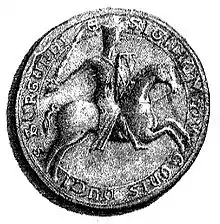| Hugh IV | |
|---|---|
 Hugh IV, Duke of Burgundy | |
| Duke of Burgundy | |
| Reign | 1218–1272 |
| Predecessor | Odo III |
| Successor | Robert II |
| Born | 9 March 1213 Villaines-en-Duesmois |
| Died | 27 October 1272 (aged 59) France |
| Spouse | Yolande of Dreux Beatrice of Navarre |
| Issue Detail | Odo, Count of Nevers John, Lord of Bourbon Adelaide, Duchess of Brabant Robert II, Duke of Burgundy Isabella, Queen of Germany |
| House | House of Burgundy |
| Father | Odo III, Duke of Burgundy |
| Mother | Alice of Vergy |
Hugh IV of Burgundy (9 March 1213 – 27 or 30 October 1272) was Duke of Burgundy between 1218 and 1272 and from 1266 until his death was titular King of Thessalonica. Hugh was the son of Odo III, Duke of Burgundy[1] and Alice de Vergy.
Issue
Hugh married twice, first to Yolande of Dreux when he was 16 and she 17 years of age.[2] He then married Beatrice of Navarre, when he was 45.[3] With Yolande, he had:
- Margaret, Lady of Molinot (1230s–1277), married first to William III, lord of Mont St Jean[4] and then to Guy VI, viscount of Limoges;[4] their daughter was the first wife of Duke Arthur II of Brittany
- Odo (1230–1266), who married Countess Matilda II of Nevers
- John (1231–1268), who married Agnes of Dampierre and had Beatrice, heiress of Bourbon
- Adelaide, who married Duke Henry III of Brabant
- Robert II (1248–1306), successor in the Duchy of Burgundy
With Beatrice, he had:
- Hugh, viscount of Avallon
- Margaret, lady of Vitteaux, wife of John I of Chalon-Arlay[5]
- Joan, a nun
- Beatrice, lady of Grignon (ca.1260–1329), who married Hugh XIII of Lusignan
- Isabella, who married King Rudolf I of Germany[5]
Expansion
Hugh IV, through a transaction with John l'Antique de Chalon, gave up the barony of Salon for the counties of Chalon and Auxonne in 1237, which expanded the Duchy[6] and the regional economy benefited from the growing wine trade.
Barons' Crusade
In 1239, Hugh joined the Barons' Crusade led by King Theobald I of Navarre and supported by Frederick II, Holy Roman Emperor.[7] The Burgundian troops allied with Richard of Cornwall and rebuilt Ascalon and negotiated a peace with Egypt in 1241.[8] Hugh was made titular king of Thessalonica in 1266,[9] although it had been recaptured by Epirus more than 40 years before.
Death
Hugh IV died on 27 October 1272 (Aged 60) at Villaines-en-Duismois, France. His burial place is unknown.
Ancestry
| Ancestors of Hugh IV, Duke of Burgundy | |||||||||||||||||||||||||||||||||||||||||||||||||||||||||||||||||||||||||||||||||||||||||||||||||||||||||||||||||||||||||||||||||||||||||||||||||||||||||||||||||||||||||||||||||||||||||||||||||||||||||||||||||||||||||||||||||||||||||||||||||||||||||||||||||||||||||
|---|---|---|---|---|---|---|---|---|---|---|---|---|---|---|---|---|---|---|---|---|---|---|---|---|---|---|---|---|---|---|---|---|---|---|---|---|---|---|---|---|---|---|---|---|---|---|---|---|---|---|---|---|---|---|---|---|---|---|---|---|---|---|---|---|---|---|---|---|---|---|---|---|---|---|---|---|---|---|---|---|---|---|---|---|---|---|---|---|---|---|---|---|---|---|---|---|---|---|---|---|---|---|---|---|---|---|---|---|---|---|---|---|---|---|---|---|---|---|---|---|---|---|---|---|---|---|---|---|---|---|---|---|---|---|---|---|---|---|---|---|---|---|---|---|---|---|---|---|---|---|---|---|---|---|---|---|---|---|---|---|---|---|---|---|---|---|---|---|---|---|---|---|---|---|---|---|---|---|---|---|---|---|---|---|---|---|---|---|---|---|---|---|---|---|---|---|---|---|---|---|---|---|---|---|---|---|---|---|---|---|---|---|---|---|---|---|---|---|---|---|---|---|---|---|---|---|---|---|---|---|---|---|---|---|---|---|---|---|---|---|---|---|---|---|---|---|---|---|---|---|---|---|---|---|---|---|---|---|---|---|---|---|---|---|---|
| |||||||||||||||||||||||||||||||||||||||||||||||||||||||||||||||||||||||||||||||||||||||||||||||||||||||||||||||||||||||||||||||||||||||||||||||||||||||||||||||||||||||||||||||||||||||||||||||||||||||||||||||||||||||||||||||||||||||||||||||||||||||||||||||||||||||||
See also
References
- ↑ Setton, Kenneth M. (1976). The Papacy and the Levant (1204–1571), Volume I: The Thirteenth and Fourteenth Centuries. Philadelphia: The American Philosophical Society. p. 492. ISBN 0-87169-114-0.
- ↑ Michael Lower, The Barons' Crusade: A Call to Arms and Its Consequences, (University of Pennsylvania Press, 2005), 97.
- ↑ Theodore Evergates, Aristocratic Women in Medieval France, (University of Pennsylvania Press, 2011), 80.
- 1 2 Du Chesne, A. (1628) Histoire géneálogique des ducs de Bourgogne de la maison de France (Paris), Preuves, p. 79-80.
- 1 2 Philippe Le Bel et la Noblesse Franc-Comtoise, Frantz Funck-Brentano, Bibliothèque de l’École des chartes, Vol. 49 (1888), 9.
- ↑ Cox, Eugene (1999). "The kingdom of Burgundy, the lands of the house of Savoy and adjacent territories". In Abulafia, David (ed.). The New Cambridge Medieval History, Volume 5, c.1198–c.1300. Cambridge: Cambridge University Press. p. 362. ISBN 978-1-13905573-4.
- ↑ Jim Bradbury, The Capetians: The History of a Dynasty, (Bloomsbury Publishing, 2007), 210.
- ↑ Jean Richard, The Crusades, C.1071-c.1291, (Cambridge University Press, 1999) 325-327.
- ↑ Topping, Peter (1975). "The Morea, 1364–1460". In Setton, Kenneth M.; Hazard, Harry W. (eds.). A History of the Crusades, Volume III: The Fourteenth and Fifteenth Centuries. Madison and London: University of Wisconsin Press. p. 109. ISBN 0-299-06670-3.